Both unknown startups and mature organizations build minimum viable products (MVPs) to test and validate their new product ideas. By doing this, they can get early feedback in order to build a full-scale solution in the right direction.
Although building an MVP version of a Software as a Service (SaaS) product is a common practice, it still hides some pitfalls not all managers and developers are aware of.
In this article, we explore how exactly MVPs can help SaaS products and what you should keep in mind when developing one. This article will be interesting for those who are considering creating an MVP for their SaaS product and for everyone interested in both the business and technical insights of this process.
Contents:
What are MVPs for SaaS?
Software as a Service (SaaS) has become an increasingly attractive and lucrative business model in recent years. The SaaS market is forecasted to reach $716.52 billion by 2028, with a growth rate of 27.5% between 2021 and 2028.
With a market this size, it’s hard for SaaS startups to get noticed and find customers. However, when a great idea is combined with the right technologies and tools, everything is possible. To prove an idea in a fast and affordable way, businesses develop an MVP prior to creating a full solution.
Minimum Viable Product or MVP is a development technique in which a new product is introduced in the market with basic features, but enough to get the attention of the consumers. The final product is released in the market only after getting sufficient feedback from the product’s initial users.
MVP definition by The Economic Times
Although the term MVP is clearly defined, there are still some common misconceptions around it. For instance, the very term itself can be slightly changed depending on the business goals:
- A Minimum Lovable Product contains only the top features of the product but makes sure they’re beautifully designed so early customers adore the product rather than merely tolerate it.
- A Minimum Acceptable Product covers core functionality just like a traditional MVP, but adds a few more functionalities to display the product’s quality.
- A Minimum Marketable Product or Minimum Sellable Product offers a limited set of features to cover primary user needs, just like an MVP. However, it’s also capable of offering value and being marketed and sold. It’s considered the best version of the MVP that you come up with after trial and error.
But the biggest confusion usually is that MVP is often used interchangeably with terms for two other deliverables: Proof of Concept (PoC) and prototype. For example, some specialists think that prototypes can be considered MVPs if they’re able to attract investors or bring in leads. That’s certainly one way to validate an idea in the wild, but there are no guarantees that the market will give your idea the same positive feedback investors do.
Turn your SaaS idea into reality
Partner with the Apriorit team to jump-start your development, design interfaces and UI/UX, and ensure the security of your product’s early version.
Let’s compare these deliverables to make sure that an MVP is exactly what your company needs:
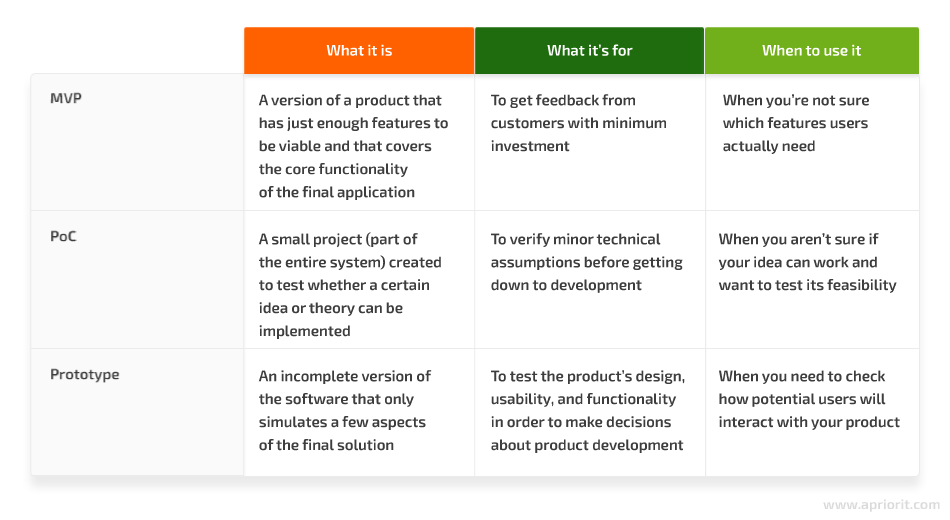
What type of solution to build first highly depends on your business goals and the specifics of your SaaS project. Note that during product development, you might need to create a few different types of solutions.
For instance, when working on software for a drone battery charging and data management unit, the Apriorit team developed a PoC and an alpha demo version to prepare key functionalities for the software and mobile apps. Only then did we move to creating an MVP to combine all the components in a single product.
But no matter how you define it, an MVP always has three key characteristics:
- Provides enough value to make the target audience want to use and purchase the product
- Demonstrates the product’s benefits to engage early adopters
- Creates a feedback loop to get valuable information needed for future development
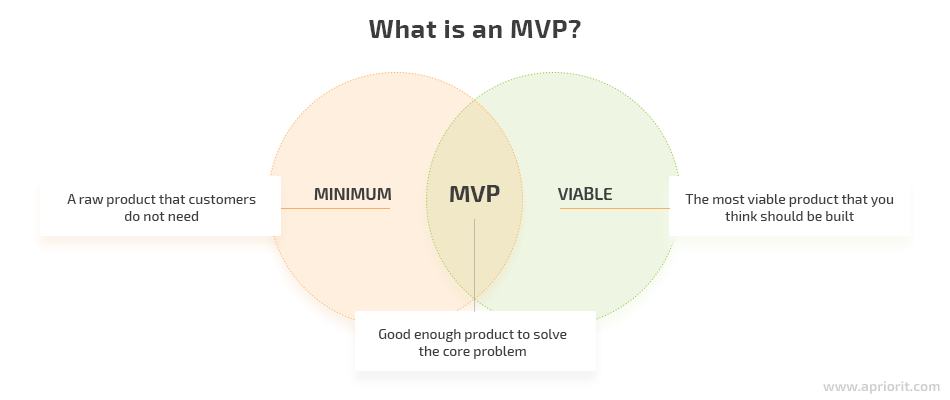
Now, let’s explore the benefits of an MVP for SaaS startups.
Read also
Cloud Application Security Best Practices: Data Safety and IT Compliance Challenges
Protect your cloud applications from evolving threats. Our experts explore five key cloud data security risks and the essential steps for ensuring compliance with regulations like GDPR, PCI DSS, and ISO/IEC 27001.

Why does your business need to build an MVP?
Full-scale SaaS solutions are budget-, resource-, and time-consuming to build from the start. MVPs, on the other hand, have much lower budgets yet are great for checking if your product’s core functionality is appreciated by end users. A lot of famous services like Dropbox, Uber, and Airbnb started as simple MVPs.
Let’s explore the main reasons why businesses see MVP development as beneficial.
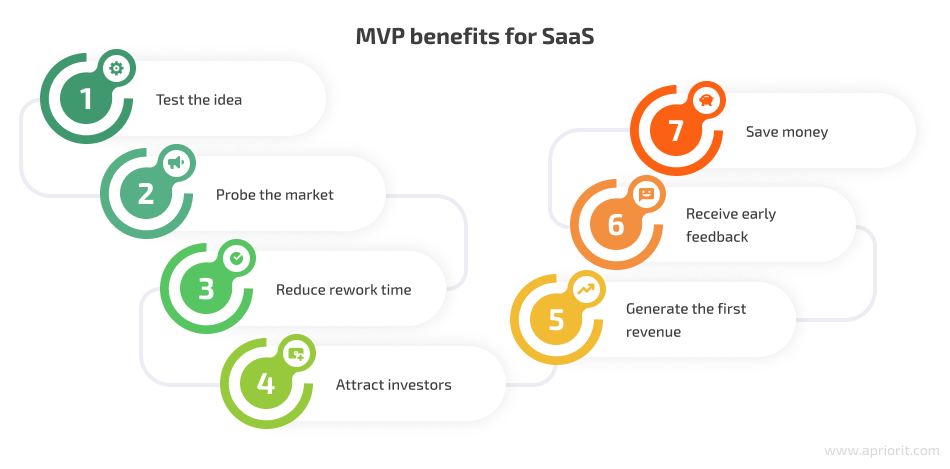
1. Test the idea
Sometimes, even the most in-depth market research can’t guarantee the success of your SaaS solution. Developing an MVP first will help you see if your business idea is sustainable and competitive enough to win over real customers.
If customers find your MVP valuable, you can continue product development and adjust the functionality so it better meets user needs. If not, you can reconsider your product’s initial idea, perform deeper market research, and use the experience gained to launch a more competitive product.
2. Probe the market
Being a complete and ready-to-use solution that has only a core feature set, an MVP offers a careful way to enter the market. It helps you check whether there will be enough demand for your solution, which is essential to know in the fast-growing SaaS market. If your product’s core functionality is based on a hyped technology, building an MVP will also help you verify current market trends and see whether they’re worth investing in.
3. Reduce rework time
Fully featured SaaS products have lots of functionalities, and each one needs to be properly developed, integrated, tested, fixed, and maintained. This is extremely time-consuming.
Building a SaaS MVP helps you focus on delivering high-quality core functionality and prevents your product from being cluttered. Therefore, you also minimize time spent on rework. Also, it’s much easier and faster to fix bugs in a small, simple application rather than in full-scale software.
4. Attract investors
SaaS products are often not trusted in the early stages of development. Proving the feasibility of a concept with marketing materials alone isn’t enough to convince both potential investors and customers. The best way to show the potential of your product and prove its worthiness is to create a functional model of the application.
Moreover, building a decent MVP is a great way to get funds from investors. Money raised thanks to the MVP can be used for further development of the full-featured product.
5. Generate the first revenue
Since MVPs are fully functional applications that meet the needs of early adopters, you can start collecting money from users. Businesses usually choose a revenue model prior to creating an MVP. This way, they can calculate the bare minimum they need to raise in order to cover development and hosting costs.
6. Receive early feedback
After releasing an MVP, you can use various methods like polls, questionnaires, feedback forms, and opinions expressed by users on social networks to find out what they think of your product. Gathering feedback on your MVP for SaaS software will help you adjust its functionality to user demands and get rid of unnecessary features. Also, user feedback is important for detecting and fixing bugs fast. Overall, by being attentive to customers’ opinions, you have a better chance of developing a successful product.
7. Save money
When developing an MVP of your SaaS application, you only spend money on core functionality and don’t pay for secondary features or unnecessary design. You can plan additional features and user experience improvements at any time, but you’ll be able to decide whether they’re needed only after receiving feedback from users. Thus, you can save money on secondary efforts until you know for sure that they’re wanted by your users.
Let’s explore some useful business tips that will help you better prepare for SaaS MVP development.
Related project
Building a Microservices SaaS Solution for Property Management
Learn from our client’s experience transitioning from a complex monolithic Ruby platform to a flexible microservices architecture. This shift not only resolved performance and maintenance challenges but also enhanced the scalability and user satisfaction of the final product.
Business advice for building a SaaS MVP
The way to plan and build a minimum viable product for SaaS heavily depends on your business idea and vision. However, several practical tips will be helpful for any MVP project:
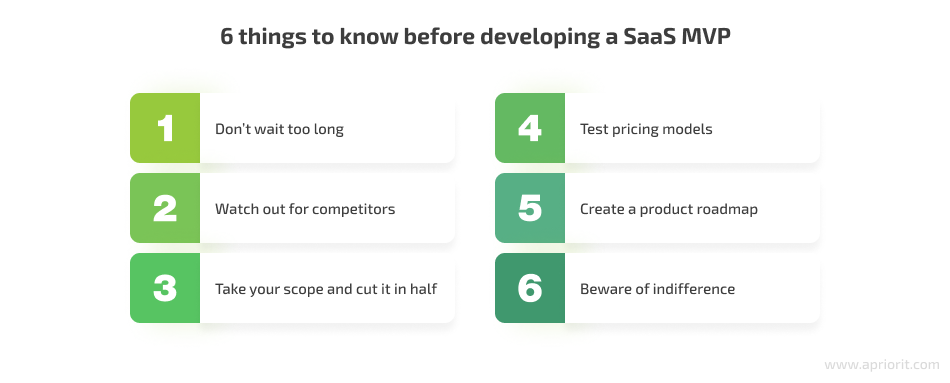
1. Don’t wait too long
One of the major mistakes with MVP development is waiting for the right time or spending too much time polishing the MVP and adding new features. Don’t treat an MVP as the full-blown product launch. You should instead think of it as version 0. Plan a short development cycle and take all the shortcuts available in order to validate your SaaS product idea with minimum investment.
2. Watch out for competitors
There’s a chance that someone has already tried to solve the same problem you’re working on. Explore similar SaaS products and try to analyze their successes and failures to consider all possible pitfalls. Use sources like Product Hunt and Crunchbase to look for direct and indirect competitors.
3. Take your scope and cut it in half
Your goal is to successfully implement the core functionality that will be valuable for end users. Extra features will end up complicating your MVP and result in more expenses. Once you have your scope ready, look at it again and think about how you can cut it. An MVP should be focused and distilled.
To prioritize features for your MVP, try to understand customer pain points. Create a detailed customer persona, focusing on who your customers are, what challenges they have, and which features they might need to address those challenges. You can also try the MoSCoW method to separate essential SaaS features from nonessential ones using a feature bucket with must-have, should-have, could-have, and won’t-have categories.
4. Test pricing models
At the MVP stage, you have an opportunity to test various pricing models and selling techniques to find the most suitable ones. A good idea for any SaaS project is to offer a free trial period if customers choose the paid version.
Consider running surveys to find out what your target audience thinks about price options and your product’s value compared to similar products on the market. This will also help you figure out which features to add to the free trial or the basic version of your MVP and which to add to paid versions.
5. Create a product roadmap
A roadmap for a SaaS project is a plan for all development and marketing stages, which is written once all product features are agreed on. A clear and well-written roadmap will help you track your product’s progress, adjust it if needed, and share necessary details with stakeholders. To create an efficient progress-based roadmap, categorize tasks into individual groups, apply agile principles, and use convenient project management tools.
6. Beware of indifference
Even if your MVP gathers negative feedback, it means that people care about the idea. They want a product based on this idea, and they want it made a certain way. Negative feedback is the perfect indicator of where to move next and how to develop your business. A much worse situation arises when you get no feedback at all. Perhaps it’s a sign for you to move on to another SaaS project.
With business nuances in mind, let’s move to the technical details of developing MVPs for SaaS products.
Read also
How to Audit AWS Infrastructure Security Effectively: Expert Tips for the Top 8 AWS Tools
Is your AWS infrastructure audit-ready? Our comprehensive guide walks you through the process of auditing AWS security, the key features to examine, the tools to use, and how to fortify your cloud environment against vulnerabilities.

MVPs from a technical standpoint
The success of your SaaS product depends not only on the quality of your idea and the set of features you provide but also on the technical decisions you make.
Let’s explore some other must-have technical qualities in detail.
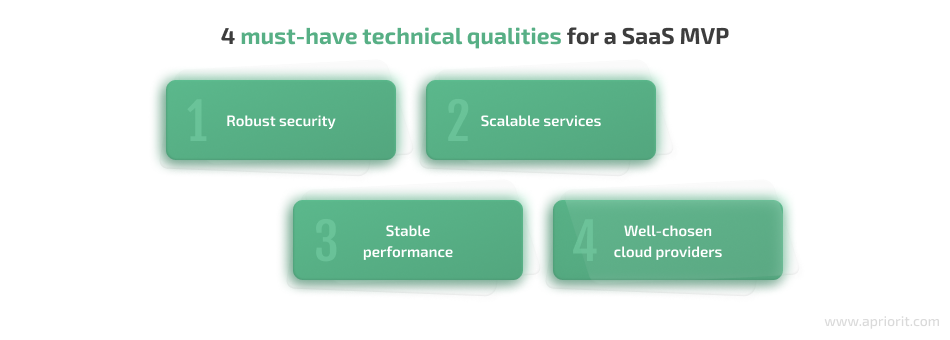
1. Robust security
The first thing you need to do when building a SaaS solution is make sure your customers know their data is secure — especially if you’re using public cloud services. If your system is gathering and processing personal data, you need to ensure that only the minimum required data is collected and that it’s thoroughly protected.
Protect data from unauthorized access from the outside and guarantee that users won’t be able to access the data of other users. Techniques you may want to use here are multi-factor authentication, encryption, multi-tenancy, and separate databases for each user. Also, make sure to use secure libraries and other third-party components.
2. Scalable services
SaaS systems usually service a huge number of users, and this should be reflected in the architecture, even at the MVP stage. If your MVP is designed to handle a certain number of users, plan how to exceed this number in the early development stages.
Your way of solving this issue should be built into the software architecture, making your SaaS project inherently scalable. For example, you can use multiple instances of software when capacity is exceeded.
By planning the application’s scalability at the early MVP stage, you save yourself from troubles and extra expenses later.
3. Stable performance
Users need to feel comfortable using your SaaS solution. Additional features and visual design are critical factors for proper user experience, but when it comes to an MVP, they’re less important. Many users will be able to overlook user interface flaws and the absence of basic features if the product is focused and answers their needs.
However, one thing people will not be able to overlook is performance. You need to create a fast and responsive system capable of reacting to user actions in a psychologically comfortable 300 milliseconds or less. In some cases, heavy optimization will be required, but this is one area where you shouldn’t cut corners, even for an MVP.
4. Well-chosen cloud providers
Leading cloud vendors like AWS, Microsoft Azure, and Google Cloud offer convenient development environments, a variety of tools, and different deployment options to help you build an efficient SaaS solution.
However, some clouds can be better than others depending on your project’s specifics and goals. You should wisely choose a cloud provider during the MVP stage so that later you can easily and conveniently expand your SaaS solution to a full-scale product without needing to migrate it to another cloud. To do that, pay attention to pricing options, storage terms, supported tools and frameworks, and other computing specifics.
Note that cloud providers and developers share responsibility for data security in the cloud. So make sure to check service-level agreements for areas of cybersecurity responsibility for cloud vendors and application developers before you choose a provider.
Related project
SaaS Growth and CI/CD Process Support with Smart AWS Infrastructure
Apriorit helped a US-based vendor revamp their cloud solution, cutting maintenance costs by 40% and boosting efficiency. Our enhancements helped the client to serve over 100,000 active users and millions of daily requests.
5 tips and tricks for developing a SaaS MVP
When сreating an MVP for a SaaS application, you should try to make the development process fast and cost-efficient — but this is often hard to achieve.
Here are some practices to consider when trying to make SaaS MVP development easier, quicker, and less expensive:
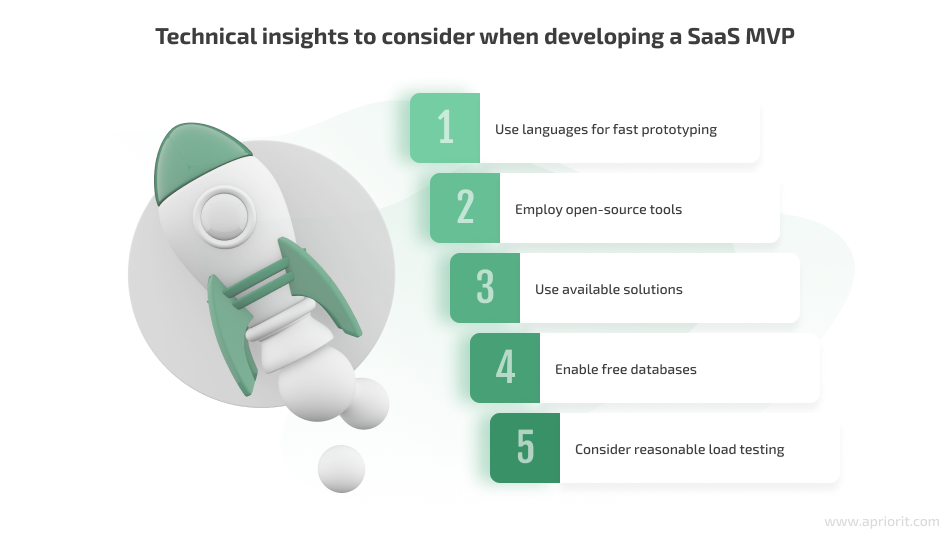
1. Use languages for fast prototyping
Programming languages such as Ruby, PHP, and Python allow for fast development and are widely used to create quick prototypes. The main disadvantage of creating solutions with these languages is that such solutions don’t scale very well and tend to have limited performance with high loads.
More complex languages and commercial frameworks, such as ASP.NET, will give you better control and better performance with high loads but require much more time and experience to work with.
If you choose to deliver your SaaS MVP to market faster with fast prototyping languages, be ready to spend additional resources later to scale your solution. Using tools like ASP.NET can take more time and resources at the MVP stage, but when implemented by experienced developers, they can save resources during further development stages.
2. Employ open-source tools
Open-source software can be an affordable and effective way to implement features, but this approach has its own limitations. The main downsides to using open-source software are lack of documentation, a high risk of multiple unknown bugs, limited backward compatibility, and no guaranteed support for older versions. As a result, open-source solutions may even prove more expensive than commercial solutions in the long term, especially if you don’t have enough experience working with them.
However, if a developer knows all the ins and outs of open-source software, it can be a great money saver at the beginning of the project. After your product moves past the MVP stage, it may be wise to replace open-source bits with commercial products, since they are more secure.
3. Use ready-to-go solutions
There’s no need to write common modules and features yourself. Features such as payment processing, usage statistics, and support chat can be resource-consuming to create from scratch. Even if you’re planning to implement artificial intelligence in your MVP, there are lots of ready-to-go AI algorithms for some common functionalities like image processing.
A lot of solutions are already available for a moderate price. Integrating as many of them as you can into your MVP will help you save time, money, and effort that can be focused on implementing your own unique ideas.
4. Enable free databases
Commercial databases are reliable, well-supported, documented, and can accommodate a large number of users. It’s paramount to use a commercial database when creating an application designed for millions of users. However, when you make an MVP, chances are you won’t have that much data at the first stages. If you aren’t expecting a huge influx of users on your first day, you can use free databases such as MySQL.
When your number of users grows to the point where a free database isn’t sufficient, you’ll be able to migrate to something commercial such as MS SQL or Oracle, but note that this migration will inevitably incur additional costs and technical challenges.
5. Consider reasonable load testing
Load testing is the most expensive type of testing, and pushing these tests back to when you actually need the capacity is an excellent way to cut costs. This type of testing is designed to assess how the system will behave under peak loads and extreme conditions.
Even if you plan to accommodate millions of users in the long run, it doesn’t necessarily mean you’ll get this many initially. When you develop a SaaS MVP, do research to gauge the potential maximum of users you’ll be able to get immediately and test for that number.
Conclusion
Developing an MVP can help you create a desired product faster, as you can work on a version of the product that only offers the most necessary functionality. Also, you get the chance to learn what your target audience thinks of your product so you can adjust your plans to better meet their needs.
Moreover, MVP development for SaaS projects is considered a low-risk investment, as you don’t put all your efforts and resources into developing a fully featured product right off the bat.
To create an MVP for your SaaS product as fast as possible with few to no bugs, make sure to gather a seasoned development team. The majority of successful projects are built with the help of outsourcing SaaS MVP development companies like Apriorit that have vast experience creating custom SaaS products.
Let’s build your next successful SaaS together!
Benefit from Apriorit’s extensive expertise in SaaS design, development, and testing to bring your idea to life.



